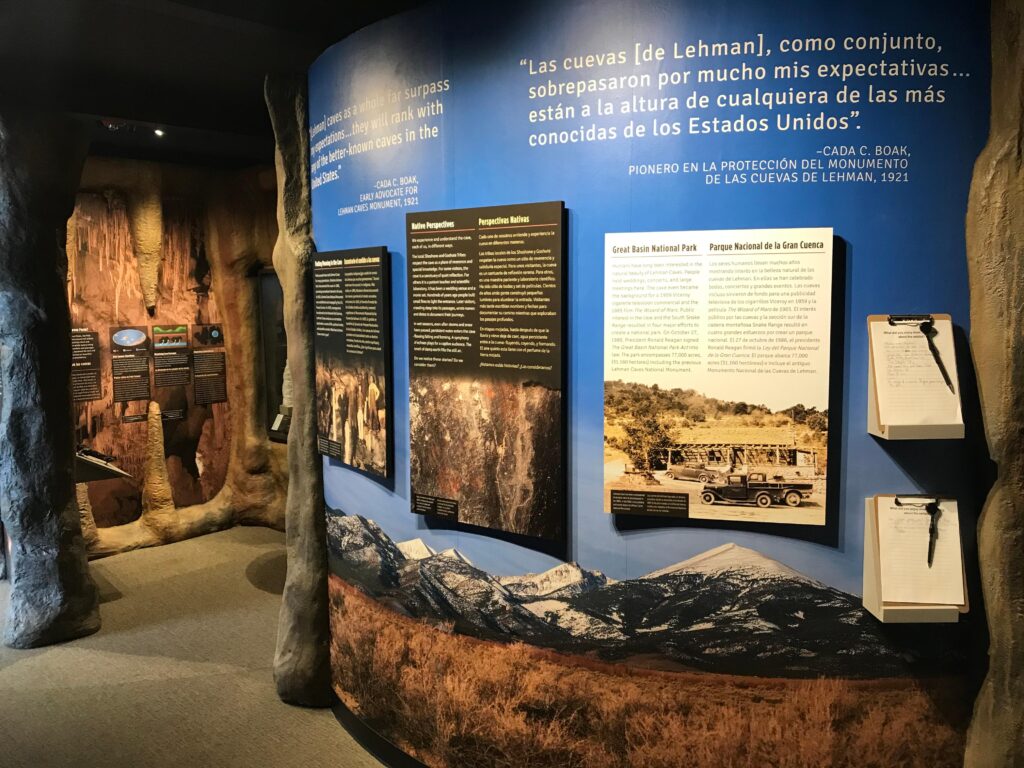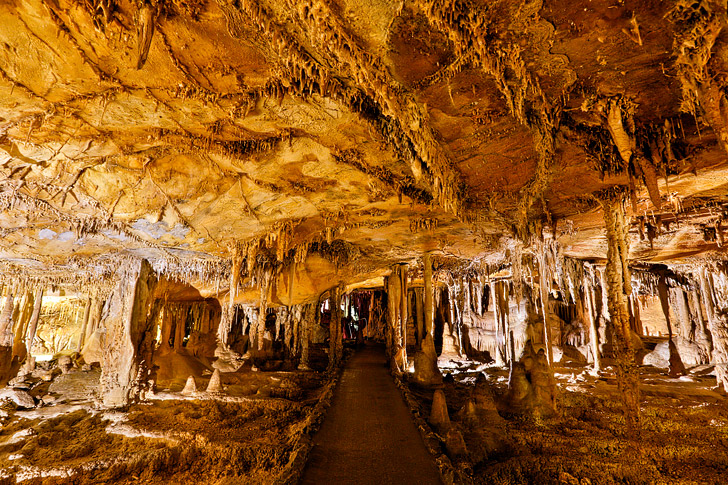Beware: You should never explore wild caves alone or without proper gear. Consider getting in touch with a Grotto of the National Speleological Society at www.caves.org or a qualified cave club. These groups are skilled and will train you. Without sufficient knowledge, preparation, and equipment, cave exploring can lead to serious injury or death.
Great Basin National Park is most famous for its Lehman Caves. Ranger-led cave tours occur daily, all year long (except over the holidays), and are always free.
Although you can schedule a tour upon arrival, if you’re planning for a trip during peak season, do so in advance. Seats go quickly. Book three to four weeks if you want to visit on the weekend during the summer and two to four weeks ahead of time if you want to visit during the week.
This 60-minute tour of the Lodge Room, Music Room and Gothic Palace covers a distance of 0.4 miles. There is only room for 20 guests, making it perfect for families with young children.
Touring the Grand Palace (about 0.9 kilometers) will take you through the Gothic Palace, the Music Room, the Lodge Room, the Inscription Room, and the Grand Palace, and will take around 90 minutes. In addition, you’ll witness the spectacular “Parachute Shield” formation. Please note that tours have a maximum capacity of 20 people.
Contact the park about arranging a private / allowed tour if you’d want additional time to shoot or bring in a tripod. The best approach to gain the chance to shoot with your camera gear is to apply for a permit, pay the charge, and then pay an additional price based on what you require.
Please go to the website for the most up-to-date information, as the timetable is subject to change. In the summer, there are five tours every day; in the fall and spring, there are two, and in the winter, there is just one.

Best Time to Visit
The caves are open all year. No matter how cold or humid it is outside, the temperature inside never drops below 50 degrees Fahrenheit.
The Great Basin National Park is most accessible in the summer and falls. Many open facilities close in the winter. Summer is an excellent time to tour because most tours repeat daily.
Directions
You should get together in the huge parking area adjacent to the Lehman Caves Visitor Center when preparing to join a tour.
What Caused the Formation of the Lehman Caves?
The Lehman Caves formed over millions of years by water erosion. Researchers determined that the caves formed 600 million years ago when a shallow sea covered the area.
Limestone caverns formed as mountain ranges pushed upward toward the sky, resulting in cracks and fissures. The caves became visible once the water level decreased, as the acidic groundwater sculpted them into their current form. The extraordinary floor, ceiling, and wall structures result from water seeping through the underlying bedrock.

Cave Formation Types
Speleothems (cave formations) coat the Lehman Caves from the ceiling down to the ground. Some more unusual forms, such as shields, pop up among the more typical ones, like stalactites, stalagmites, and columns.

The current state of affairs has its roots in a timeframe stretching back hundreds of thousands of years. At the horizontal water table, surface water is slightly acidified by carbon dioxide gas combined with water from great depths to dissolve the soluble rock.
Sphere-shaped domes in the ceiling and spoon-shaped scallops on the walls testified to the dissolving impact of the slowly circulating water on the cave’s limestone walls. In time, the cave’s water level dropped, revealing its hollow chambers and sculpted walls.
This led to the emergence of the second phase of cave growth. Water seeped underground, carrying trace amounts of dissolved limestone (calcite).
Insignificant trickles deposited monumental stone works over centuries. This gives scientists a chance to study various cave formations known as speleothems.
Familiar cave features like stalactites, stalagmites, columns, draperies, flowstone, and soda straws litter the majestic scenes in Lehman Caves.
Rare items include shields, which have two approximately circular plates joined together like fattened clam shells. These shields typically featured elegant stalactites and drapery dangling from their lower plate. The quantity of shields in Lehman Caves is one of the attractions there.
The unique and exciting structures in Lehman Caves, such as the Parachute shield, make visiting the caves worthwhile. Anthodites, tiny needle-like crystals of aragonite, and helictites, minuscule branching formations that resist gravity, lay all around the caverns. Cave walls decorated with cave popcorn remind students of the movies.
Complete List of Cave Formations to Look Out For

Here are some frequently used ones if you’re looking for some basic formats. The cave bacon is not to be missed.
- Dripstone is a stone formed by water dropping
- Stalactites: dangling rock structures
- Soda Straws are long, narrow, and cylindrical stalactites.
- Helictites are a form of stalactite that appears to defy the laws of nature since it grows in an upward direction.
- Chandeliers are intricate clusters of ceiling décor.
- Ribbons are a type of stalactite that grow in the shape of thin strips of rock.
- Stalagmites are elongated, stony outcrops that have sprung from the earth.
- Broomstick – Extremely tall and slender
- Totem Pole – Extremely Tall and Designed After Totem Poles
- “Fried Eggs” are short stalagmites that are broader than tall.
- Flowstone – sheet-like structures seen on floors and walls
- Draperies and Curtains are delicate, undulating sheets
- Bacon: a pattern of varying colors across the bed.
- Stone Waterfall – appears to be a frozen cascade.
Other Formations
- Small, knobby bunches of popcorn.
- A shield consists of two circular or oval plates parallel to one another and splits down the middle.
Learn more about cave formations here.
Who is Absalom Lehman in Regard to the Lehman Caves?
Nearby Native Americans had frequented the caves before Absalom Lehman’s arrival. Back in 1885, he led the first comprehensive tour of the Lehman Caves.
On January 6, 1827, in Chambersburg, Pennsylvania, Absalom Lehman entered the world. The man spent time in Ohio, California, Nevada, and Australia before settling with his future wife in the latter country. He worked as a ranch hand, ranch owner, and gold miner. It’s thought that Absalom stumbled upon the caves during his second stay in Nevada.
An Overview of the Tour
The only way into Lehman Caves is on a guided tour led by a park ranger. Aside from Thanksgiving Day, Christmas Day, and New Year’s Day, cave excursions run every day of the year. In addition, all tours are led by park rangers who provide insight into the cavern’s geology, ecology, and history.
The Lodge Room Tour and the Grand Palace Tour will be available in the summer of 2022. We restrict our trips to the lodge during the colder months, and tours of the Gothic Palace are only offered on busy weekends or when there is enough manpower. Most cave tours are already booked weeks in advance.

Grand Palace Tour (Not offered in winter)
On average, a tour of the Grand Palace takes about 90 minutes. Children must be at least 5 years old to participate in the 0.6-mile-long Grand Palace Tour (except on tours from November through February).
The trip will take you to the Gothic Palace, the Music Room, the Lodge Room, the Inscription Room, and the Grand Palace at Lehman Caves, where you will see the famed “Parachute Shield” formation. Only 20 people can go on the tour, and a test for White Nose Syndrome must be performed on all incoming students.
Lodge Room Tour
The Lodge Room tour lasts about an hour and a half and covers nearly half a mile inside the cave. When tours of the Gothic Palace are not given, kids of any age are welcome to come along.
Along the route, you’ll stop in the Lodge Room, the Music Room, and the Gothic Palace. Please note that tours have a maximum capacity of 20 people, and testing for White-Nose Syndrome is Required.
Tour of the Gothic Palace (Not offered in winter)
Tours of the Gothic Palace typically last for half an hour, and families with little children will find this ideal. Getting to the Gothic Palace takes less than a quarter of a mile of the tour’s time within the cave. This tour will highlight the numerous cave formations and exciting background of this elaborately decorated chamber. Only 20 people can go on the tour. A test for White Nose Syndrome must be performed on all incoming students.

Tour of the Parachute Shield (Not offered in winter)
It takes roughly 1 hour and 30 minutes to complete a Parachute Shield Tour. The Parachute Shield Tour has a distance of 0.5 miles and consists primarily of traversing vast chambers connected by steep staircases and narrow corridors. On this trip, we’ll be going to the Grand Palace, the Inscription Room, and the Lodge Room. Only 20 people can go on the tour. A test for White Nose Syndrome will determine access for all incoming students.
Costs of Tickets
Unlike entrance fees, the cost of a cave tour is not included in the price of an Annual Pass. However, discounts are available for those with a Golden Age/Senior Pass or Golden Access card. Please note that the discount card is valid only for the cardholder and not for immediate family members.
Prices for tickets vary depending on the type of tour you’d want to take. See specifics below.
Parachute Shield Tour (60 Minutes)
- Adults (16+): $12.00
- Kids and Teens (5-15): $6.00
- Infants and Toddlers: Free!
- Golden Age/Senior Pass (cardholders only): $6.00
- Access Pass (cardholder only): $6.00
Gothic Palace Tour (30 Minutes)
- Adults (16+): $8.00
- Kids and Teens (5-15): $4.00
- Infants/toddlers: Free!
- Golden Age/Senior Pass (cardholder only): $4.00
- Access Pass (cardholder only): $4.00
Grand Palace Tour (90 Minutes)
- Adults (16+): $15.00
- Youth (5-15): $8.00
- Infants/toddlers: Free!
- Golden Age/Senior Pass (cardholders only): $7.50
- Access Pass (cardholders only): $7.50
